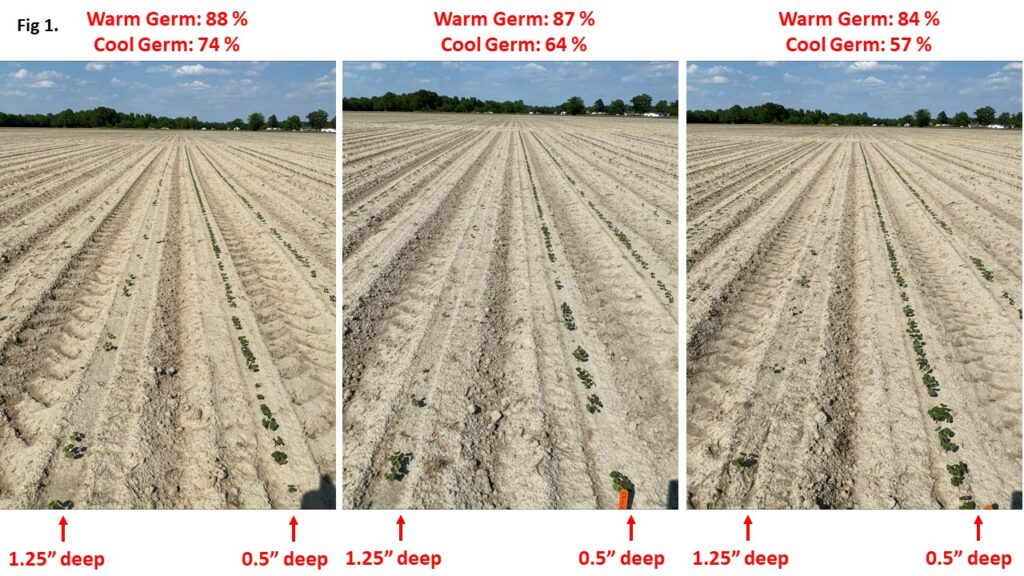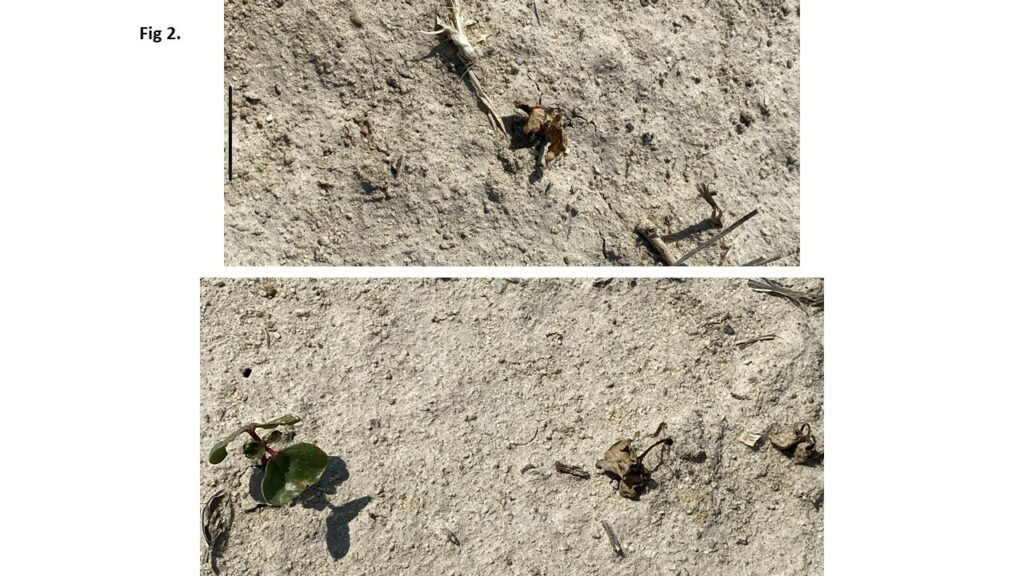Evaluating Plant Stands, and Decisions Moving Forward (Collins, Edmisten, Reisig, Huseth, & Cahoon)
go.ncsu.edu/readext?799820
en Español / em Português
El inglés es el idioma de control de esta página. En la medida en que haya algún conflicto entre la traducción al inglés y la traducción, el inglés prevalece.
Al hacer clic en el enlace de traducción se activa un servicio de traducción gratuito para convertir la página al español. Al igual que con cualquier traducción por Internet, la conversión no es sensible al contexto y puede que no traduzca el texto en su significado original. NC State Extension no garantiza la exactitud del texto traducido. Por favor, tenga en cuenta que algunas aplicaciones y/o servicios pueden no funcionar como se espera cuando se traducen.
Português
Inglês é o idioma de controle desta página. Na medida que haja algum conflito entre o texto original em Inglês e a tradução, o Inglês prevalece.
Ao clicar no link de tradução, um serviço gratuito de tradução será ativado para converter a página para o Português. Como em qualquer tradução pela internet, a conversão não é sensivel ao contexto e pode não ocorrer a tradução para o significado orginal. O serviço de Extensão da Carolina do Norte (NC State Extension) não garante a exatidão do texto traduzido. Por favor, observe que algumas funções ou serviços podem não funcionar como esperado após a tradução.
English
English is the controlling language of this page. To the extent there is any conflict between the English text and the translation, English controls.
Clicking on the translation link activates a free translation service to convert the page to Spanish. As with any Internet translation, the conversion is not context-sensitive and may not translate the text to its original meaning. NC State Extension does not guarantee the accuracy of the translated text. Please note that some applications and/or services may not function as expected when translated.
Collapse ▲The 2021 planting season has been yet another challenge in North Carolina. During the early part of the planting window, it appeared that weather was going to be cooperative. However, prolonged periods of cool temperatures, especially at night, prevailed for quite a while, and now the lack of soil moisture has been frustrating when trying to get this crop going.
Today, May 25, 2021, marks our first deadline for crop insurance, although most growers were able to get the last of their crop planted before now. Now is the time to be evaluating this crop to determine if replanting may be necessary in some fields. With June just around the corner, action should be taken quickly, if needed, however our current lack of soil moisture will continue to delay this crop until a statewide rain brings us some reprieve.
Evaluating Plant Stands & Replanting Decisions:
We are currently wrapping up some research that will help us make better replanting decisions. Although variable from environment to environment, this current research suggests that, on average, replanting could be justified when approximately 30 % or more of the planted area is occupied by 3-foot skips, assuming replanting costs of approximately $35/A (including fuel, labor, equipment, and replanting seed). Assessing plant stands and the size/frequency of skips with precision is critical to making replanting decisions. A survey was conducted during 2019 where several experts were asked to visually evaluate various plots and provide an estimate for the percentage of the planted area occupied by 3-foot skips. Responses ranged from 30 to 80 %, with an average estimate of 59 %, whereas the actual percentage was 71 %. This variation illustrates that visual assessments of plant stands are often insufficient or not precise. The only way to currently make assessments for replanting with any precision is manual measurement of multiple, small representative areas at several places within a field. This research also illustrated that UAV technology could be used to precisely measure the size/frequency of skips within a field in a much more timely manner, however the software has yet to be developed for accurate assessments at the scale of commercial fields.
Replanting Decisions & Current Challenges This Year:
Usually when replanting decisions are made, cotton had been planted into good soil moisture and a failed or questionable stand can be attributed to a particular cause such as a packing rain, excessive rain, or cool temperatures, etc. Our current lack of soil moisture presents a very challenging scenario in that we do not, nor will we, know what kind of stands we have until a sufficient rain allows for all seed to germinate and emerge. We’ve received several calls from growers over the past couple of weeks, inquiring whether to plant deep in an effort to “chase” moisture or to plant shallow and “dust in” cotton. Our advice in nearly all cases was to dust in cotton into completely dry soil and wait on a rain, simply because deep planting frequently leads to more problems and poor stands. Our observations over the past several years suggest that cotton seed, if planted shallow and into completely dry soil, will wait quite a while for a rain, but we do not know exactly how long, given soil temperature fluctuations, etc.
In conditions such as what we have recently experienced, planting deep in search of soil moisture is usually a failed practice, because when moisture is already limited, the limited moisture that seed may encounter at those deeper depths is likely to deplete further. In such cases, there may be enough moisture to initiate germination, but not enough for seedlings to reach full emergence. Additionally, deep planting adds significant stress to the already-stressed seedlings, even when adequate soil moisture returns. The only way the deep planting leads to good results is if a rain comes fairly soon after planting without forming a surface crust, in which deep planting would be unnecessary anyway. Figure 1. below illustrates the effect of deep planting on various varieties/lots, all of which have acceptable warm germ and average or better cool germ. These plots were planted into sufficient soil moisture during a cool period within the first three days of planting, followed by acceptable to ideal temperatures. These photos were taken at 27 days after planting, which is well beyond the point of needing to make a replanting decision if cotton was planted into sufficient moisture. Naturally, since cotton was planted into sufficient moisture, which favors shallow planting, the point IS that moisture was not limited for germination, therefore the effects of deep planting could easily be observed. In our current situation, shallow planted cotton would likely just sit there and wait on a rain, whereas deep planting into marginal, yet depleting, soil moisture would still likely result in poor stands.
We’ve received calls over the past couple of days from growers evaluating their stands and wanting guidance on replanting. The particularly challenging problem that is unique to this year is that in many cases, there are some seedlings emerged, some that have cracked and barely emerged but dried up and died (see Figure 2. below) due to moisture depletion, and some seed were planted into dry soil and have yet to germinate or emerge.
Usually, when we make stand assessments or replanting decisions, we know that additional germination is not likely. Again, failed stands in most years can easily be pointed to a particular cause, but our current lack of moisture leaves us wondering if an acceptable stand can be achieved once a rain allows for such. In most cases that we’ve seen, there are a mixture of emerged seedlings, dead seedlings, and seed waiting for moisture, therefore we cannot visually assess plant stands with any precision. In order to make replanting decisions (with careful consideration to 3-foot skips or greater) with any precision, one must dig down into the furrow to see what proportion of seedlings are dead and how many seed are waiting on a rain. This can be tedious, but we can’t see any way around it until a rain comes.
If replanting is needed, give careful consideration to herbicides that you have previously used (see Dr. Cahoon’s comments below). We get questions every year about whether the currently emerged seedlings should be destroyed before replanting. Generally, we advise to leave the currently emerged seedlings alone and replant into the same furrow or slightly to the side. There are generally 2-3 weeks differences in maturity within any field in NC, simply due to soil variation within the field. Therefore, maturity differences between planting dates are often miniscule, and we often rely on the currently emerged seedlings to fill gaps in case the second planting is not as successful as we would like.
Be Scouting for Thrips:
Also unique to this year, seed planted into dry soil also means that neonicotinoid seed treatments or in-furrow liquids may diminish or expire before germination and emergence. Whenever delayed emergence occurs, whether it is the result of deep planting, cool weather, or planted dry and waiting on rain, growers should expect reduced thrips efficacy from seed treatments or in-furrow liquids. Therefore, growers should be diligent in scouting for thrips and taking quick and timely action with a foliar acephate spray if needed for any fields that will not be replanted, or even in replanted fields for seedlings that will be kept. Remember, seedlings are susceptible to thrips injury until the three to four-leaf stage, so variable aged stands may complicate foliar spray decisions. If adequate soil moisture does arrive, newly emerged stands should rapidly grow through the thrips susceptibility window. Even so, thorough scouting will be necessary to determine if younger seedlings require additional treatment, if efficacy of seed treatments or in-furrow liquids is reduced or expired due to delayed emergence. When replanting, be sure the check the label for season-long limits of in-furrow liquids to determine how much, if any, can be applied in the second planting. Also, see the NC Cotton Insect Scouting Guide for thrips thresholds when deciding if a foliar spray is needed.
Replanting and Herbicides:
Cotton can be safely replanted following Brake, Cotoran, Direx, Prowl, Reflex, and/or Staple LX. However, growers should exercise caution when replanting into previously applied Warrant. There is a reason the EC formulation of acetochlor is not labeled for preemergence use in cotton; once the capsules of Warrant break down, you are left with unencapsulated acetochlor. As demonstrated by research here in North Carolina, replanted cotton is not always injured by Warrant; injury is highly dependent on weather and proximity of the herbicide to replanted cotton seed. However, when injury does occur it can be significant and ultimately reduce cotton yield. In line with recommendations from Dr. Stanley Culpepper at University of Georgia, we recommend waiting at least 3 weeks to replant cotton after Warrant application in no-till situations. If willing to bring fresh soil into the planting zone via a ripper shank, the replant interval can be shortened to 2 weeks.




